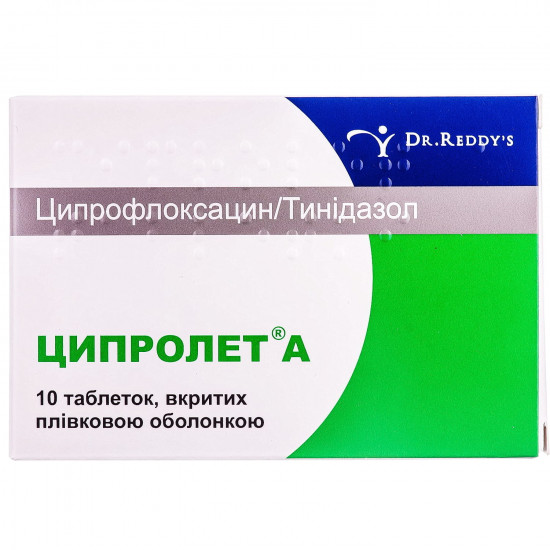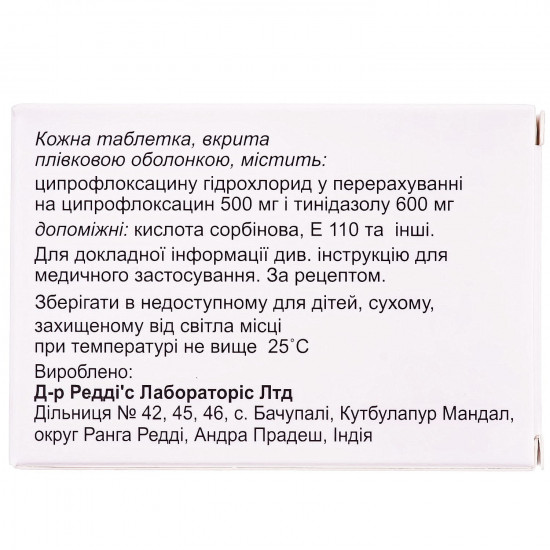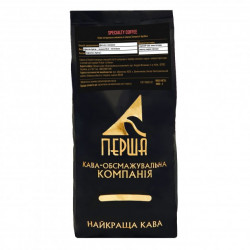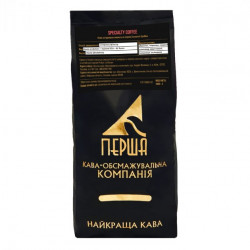



- Stock: In Stock
- Model: 178955
0% Customers recommend this product
-
5 Awesome0%
-
4 Great0%
-
3 Average0%
-
2 Bad0%
-
1 Poor0%
Reviews Over Tsiprolet And tab. of p/o No. 10
- (0)
Total Reviews (0)
click here write review to add review for this product.
Report this review.
Description
Pharmacological properties
Pharmacodynamics
tsiprolt Pharmacological properties of medicine and are caused by pharmacological properties of each its substance. the mechanism of effect of ciprofloxacin is caused by oppression of bacterial enzyme of a dnk-giraza of bacteria. violation of volume structure of DNA of bacteria is result of such oppression and makes impossible further division of bacterial cages. ciprofloxacin is active concerning gram-positive and gram-negative bacteria.
Spectrum of action of ciprofloxacin covers such microorganisms:
aerobic gram-negative bacteria — Escherichia coli, Klebsiella pneumoniae, Salmonella typhi, Proteus mirabilis, Proteus vulgaris, Shigella sonnei, Shigella boydii, Shigella dysenteriae, Shigella flexneri, Enterobacter cloacae, Morganella morganii, Providencia rettgeri, Providencia stuartii, Citrobacter diversus, Citrobacter freundii, Serratia marcescens, Campylobacter jejuni, Pseudomonas aeruginosa, Neisseria gonorrhoeae, Haemophilus influenzae, Haemophilus parainfluenzae, Bacillus anthracis., Moraxella catarrhalis;
aerobic gram-positive bacteria — staphylococcus, including the strains producing penicillinase and the strains resistant to Methicillinum, streptococci, including Streptococcus pneumoniae, Listeria monocytogenes, Corynebacterium spp.
Tinidazolum is derivative 5 nitroimidazoles with the substituted imidazolovy component which is capable to work against anaerobic bacteria and protozoa. And protozoa connect the mechanism of effect of Tinidazolum on anaerobic bacteria with penetration of medicine into cells of microorganisms and with damage of DNA or oppression of its synthesis.
Tinidazolum is active as concerning simple, and obligate anaerobic bacteria. The simplest microorganisms sensitive to Tinidazolum include Trichomonas vaginalis, Entamoeba histolytica and Giardia lamblia.
Tinidazolum is activein relation to Gardnerella vaginalis and the majority of anaerobic bacteria, including Bacteroides fragilis, Bacteroides melaninogenicus, Bacteroides spp., Clostridium spp., Eubacterium spp., Fusobacterium spp., Peptococcus spp., Peptostreptococcus spp. and Veillonella spp.
PharmacokineticsCiprofloxacin is quickly soaked up by
after oral administration. The bioavailability is about 70%. Food does not influence extent of absorption of ciprofloxacin, but can slow down absorption speed. The C max ciprofloxacin in blood plasma is reached in 1–2 h. Ciprofloxacin reaches therapeutic concentration almost in all fabrics and liquids of an organism. Linking with proteins of blood plasma insignificant — 20–40%. The t ½ makes 3–5 h
Tinidazolum is quickly and completely soaked up at intake.
After intake of Tinidazolum in a dose of 2 g in concentration in blood plasma reached peak in 40–51 mkg/ml during 2 h and decreased to 11–19 mkg/ml in 24 h. The t ½ Tinidazolum makes 12–14 h of blood plasma. Tinidazolum is actively distributed on all body tissues and gets through GEB. Nearly 12% of Tinidazolum in blood plasma contact proteins. Tinidazolum is emitted with a liver and kidneys. Within 5 days of 60-65% of the entered dose 20–25% are removed with urine, and — in not changed look. About 12% of a dose are removed with a stake.
Indication
Infection, caused by microorganisms, sensitive to drug, including the mixed aerobic-anaerobic infections, protozoan infections: airways — pleurisy, a pleura empyema, abscess of lungs; ENT organs — chronic sinusitis, a mastoiditis; skin and soft tissues — the infected ulcers, abscesses, cellulitis, infections of soft tissues at patients with diabetes; a GIT — bacterial diarrhea, dysentery, an amebiasis, other multi-infections of a GIT; intraabdominal infections; gynecologic infections; infections of bones — chronic osteomyelitis; dental infections.
UseUsual dose of medicine tsiprolt
and for adults — 1 tablet 2 times a day. apply at adults inside for 1 h to or in 2 h after a meal. it is necessary to swallow of tablets without chewing, washing down with a small amount of liquid. for patients with clearance of creatinine of 31-60 ml/min. the maximum daily dose of medicine has to make 2 tablets a day, for patients with clearance of creatinine of ≤30 ml/min. — 1 tablet a day. at infections of a heavy current of abdominal organs, airways, at chronic osteomyelitis the maximum daily dose — 3 tablets a day. the course of treatment depends on weight of an infection and results of bacteriological researches. the usual course of treatment at sharp infections makes 5–7 days, but in case of treatment of persistent recurrent infections the course of treatment makes 10–14 days. it is recommended to continue administration of medicament during at least 3 days after normalization of body temperature or elimination of symptoms of a disease. Contraindication
Hypersensitivity to ciprofloxacin or other ftorkhinolona, hypersensitivity to Tinidazolum or other derivatives 5 nitroimidazoles, organic neurologic violations, blood diseases in the anamnesis, the period of pregnancy and feeding by a breast, children's age.
Side effects
from a digestive tract: nausea, diarrhea, increase in level of hepatic Transaminases (alat, asat), shchf, vomiting, dispeptic phenomena, abnormal values of tests for function of a liver, anorexia, meteorism, hyperbilirubinemia, oral candidiasis, jaundice, cholestatic jaundice, pseudomembranous colitis, liver necrosis, pancreatitis, hepatitis, metal smack, abdominal pain, coated tongue, glossitis, stomatitis.
from nervous system: dizziness, sleep disorders, agitation, confusion of consciousness, migraine, hallucinations, the increased sweating, paresthesias, emotional violations (concern, fear, alarm), sleep disorders, spasms, a hyperesthesia, a depression, a tremor, unstable gait, psychosis, increase in intracranial pressure, an ataxy, twitching, a headache, peripheral neuropathy, touch violations.
from a cardiovascular system: tachycardia, migraine, syncope (faint), vazodilatation, arterial hypotension, vasculitis.
from the system of blood formation: an eosinophilia, a leukopenia, anemia, a leukocytosis, the changed values of level of a prothrombin, thrombocytopenia, a thrombocytosis, hemolytic anemia, petechias, the Agranulocytosis, a pancytopenia, oppression of function of marrow.
from the musculoskeletal system: arthralgia, myalgia, hypostasis of joints, myasthenia, tendinitis (mainly Achilles tendon), injuries of sinews.
from an urinogenital system: increase in level of creatinine, urea nitrogen in blood, OPN, a renal failure, vaginal candidiasis, a hamaturia, a crystalluria, interstitial nephrite, urine darkening.
from a respiratory system: dispnoe, laryngeal edema.
Reaction of hypersensitivity and change from skin: skin rash, an itch, makulopapulezny rash, a small tortoiseshell, allergic reactions, medicamentous fever, anaphylactic reactions (including an acute anaphylaxis), the reaction similar to a serum disease, a petechia, a multiformny erythema, a nodular erythema, Stephens's syndrome — Johnson, a toxic epidermal necrolysis, photosensitivity, a Quincke's disease.
metabolism Disturbance: hypostases, hyperglycemia, superactivity of amylase, superactivity of a lipase.
from sense bodys: violation of taste, sonitus, temporary deafness, disorder of vision, diplopia, chromatopsia, parosmiya, violation of feeling of smells.
from an organism in general: abdominal pain, candidiasis, adynamy, extremity pain, dorsodynia, stethalgia, inflows.
Special instructions
during medicament treatment should not take alcoholic beverages. the patient with epilepsy, with attacks of spasms in the anamnesis, with vascular diseases and organic lesions of a brain in connection with danger of development of side reactions from central nervous system, medicine tsiprolt and it is necessary to appoint only according to vital indications. at emergence during treatment of side reactions from central nervous system the use of medicine should be stopped. at emergence in time or after medicament treatment tsiprolt and heavy and long diarrhea it is necessary to exclude the diagnosis of pseudomembranous colitis which demands immediate medicament withdrawal and purpose of the corresponding therapy. at patients with abnormal liver functions and/or kidneys control of concentration of ciprofloxacin in blood plasma is recommended. for patients of advanced age the dose adjustment is not required. in certain cases the hypersensitivity and allergic reactions note after the first intake of ciprofloxacin. seldom or never anaphylactic reactions, life-threatening the patient can progress. in these cases the intake of ciprofloxacin needs to be stopped and to immediately carry out medicament treatment. at any symptoms of a tendinitis it is necessary to stop immediately medicament treatment and to avoid physical activity. ciprofloxacin can cause emergence of a photosensitization therefore during treatment it is necessary to avoid direct solar radiation. at emergence of reactions of photosensitivity the therapy by ciprofloxacin needs to be stopped. the patients accepting tsiprolt and, have to use enough liquid in order to avoid a crystalluria.
Ability to influence speed of response at control of vehicles or work with other mechanisms. During treatment it is necessary to abstain from control of the vehicles and/or other mechanisms demanding the increased concentration of attention and speed of psychomotor reactions.
Use during pregnancy and feeding by a breast. Drug is contraindicated during pregnancy and feeding by a breast.
Children. The efficiency and safety of use of medicine in pediatric practice are not established therefore at children it is not applied.
Simultaneous use of medicine tsiprolt
Interaction
and with iron preparations, sukralfaty and the antiacid means containing magnesium, aluminum, calcium and medicines with a big buffer tank (for example antiretroviral means) the intensity of absorption of ciprofloxacin reduces. in this regard tsiprolt and it is necessary to appoint for 1–2 h to or in 4 h after intake of the specified medicines. the specified restriction does not concern a class of blockers of h2-histamine receptors. simultaneous use of theophylline and ciprofloxacin leads to increase in concentration of theophylline in blood plasma and to its lengthening т½. at simultaneous use of medicine with cyclosporine in some cases note increase in content of creatinine in blood plasma. tsiprolt and increases concentration and extends т½ indirect anticoagulants and oral hypoglycemic means. ciprofloxacin influences caffeine metabolism, increasing it т½. at simultaneous use of ciprofloxacin and Phenytoinum it was reported about changes of level of Phenytoinum in blood plasma (increase or lowering). the combined use of medicine tsiprolt and and the probenetsida is followed by increase in concentration of ciprofloxacin in blood plasma. Metoclopramidum accelerates absorption of medicine tsiprolt and owing to what the period of achievement of cmax of ciprofloxacin in blood plasma is reduced (it does not affect bioavailability of the last).in case of sharp overdose messages about nephrotoxicity were p>
. specific antidote is unknown. in case of overdose it is necessary to wash out a stomach. the patient it is necessary to observe and carry out carefully maintenance therapy, including monitoring of function of kidneys and introduction of the antacids containing magnesium, aluminum or calcium which can reduce ciprofloxacin absorption. it is necessary to support an adequate water relationships. Tinidazolum is easily removed at dialysis. ciprofloxacin by means of a hemodialysis or peritoneal dialysis is removed in a small amount (10%). Storage conditions
B the dry, protected from light place, at a temperature not above 25 °C.
Specifications
| Characteristics | |
| Active ingredients | Tinidazolum, Ciprofloxacin |
| Applicant | Dr.Reddy' s |
| Code of automatic telephone exchange | J01RA04 Spheromycinum, combinations with other antibacterial agents |
| Interaction with food | To |
| Light sensitivity | Sensitive |
| Market status | Traditional |
| Origin | Chemical |
| Prescription status | According to the prescription |
| Primary packing | blister |
| Producer | DR. OF REDDIS LABORATORIS LTD |
| Quantity in packing | 10 tablets |
| Release form | tablets for internal use |
| Route of administration | Oral |
| Sign | Import |
| Storage temperature | from 5 °C to 25 °C |
| Trade name | Tsiprolet |




















